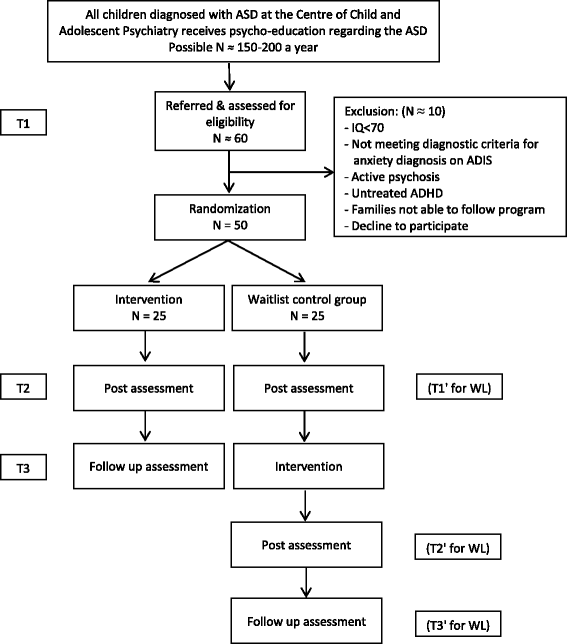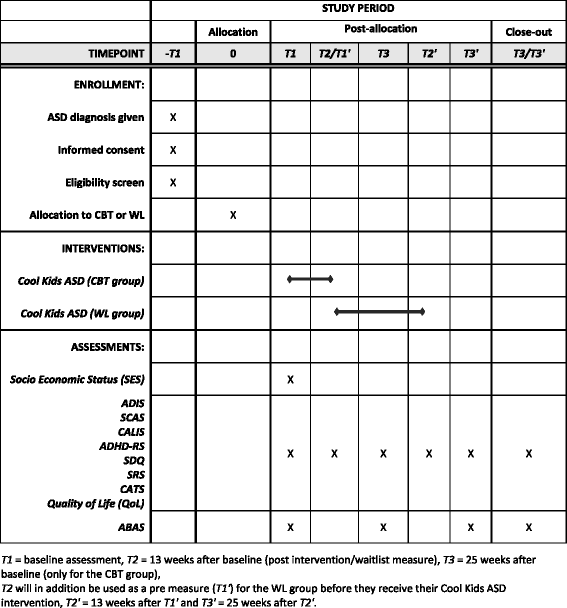Rationale and design for cognitive behavioral therapy for anxiety disorders in children with autism spectrum disorder: a study protocol of a randomized controlled trial
- PMID: 29609630
- PMCID: PMC5879814
- DOI: 10.1186/s13063-018-2591-x
Rationale and design for cognitive behavioral therapy for anxiety disorders in children with autism spectrum disorder: a study protocol of a randomized controlled trial
Abstract
Background: Autism spectrum disorder (ASD) is found in approximately 1% of the population and includes core symptoms that affect general and social development. Beside these core symptoms, it is suggested that up to 60% of children with ASD suffer from comorbid anxiety disorders which may further affect educational, social and general development as well as quality of life. The main goal of this study is to examine the effectiveness of a manualized cognitive behavioral therapy (CBT) anxiety program adapted for children with ASD.
Methods: This study is a randomized controlled trial (RCT). Fifty children with ASD and anxiety, aged 7 to 13 years, will be randomly assigned to group CBT or a wait-list control (WL) condition. The design will follow a two (CBT and WL) by two (pre-post assessment) mixed between-within design. The control group will receive intervention after the waitlist period of 13 weeks. Primary outcomes are diagnostic status and severity of the anxiety disorders, measured with The Anxiety Disorder Interview Schedule for DSM-IV, Parent and Child Versions. Secondary outcomes are parent and child ratings on questionnaires on the child's level of anxiety and impact on everyday life. Additional outcomes entail information gathered from parents, child and teachers on the child's behavior and negative self-statements, together with social and adaptive skills. Follow-up data will be collected 3 months after intervention.
Discussion: This study aims to evaluate the effectiveness of a manualized CBT program in Danish children with ASD and anxiety within a mental health clinic setting. The hypothesis is that training anxiety reduction skills will decrease anxiety in children, as well as ensure better psychosocial development for the child in general.
Trial registration: https://ClinicalTrials.gov ( NCT02908321 ). Registered 19th of September 2016.
Keywords: Autism spectrum disorder; anxiety disorders; children; cognitive behavioral therapy.
Conflict of interest statement
Authors’ information
N/A
Ethics approval and consent to participate
The study has obtained approval from the Regional Ethics Committees (j.no.1–10–72-46-15) and The Danish Data Protection Agency (j.no. 1–16–02-263-15). We will/have obtain(ed) oral and written informed consent from all participants in the study.
Consent for publication
N/A
Competing interests
RR is an author of the original Cool Kids manuals and TRK is an author of the revised Cool Kids ASD manual 2nd Ed, but neither receives any royalties. The remaining authors declare that they have no competing interests.
Publisher’s Note
Springer Nature remains neutral with regard to jurisdictional claims in published maps and institutional affiliations.
Figures
References
Publication types
MeSH terms
Associated data
Grants and funding
LinkOut - more resources
Full Text Sources
Other Literature Sources
Medical



